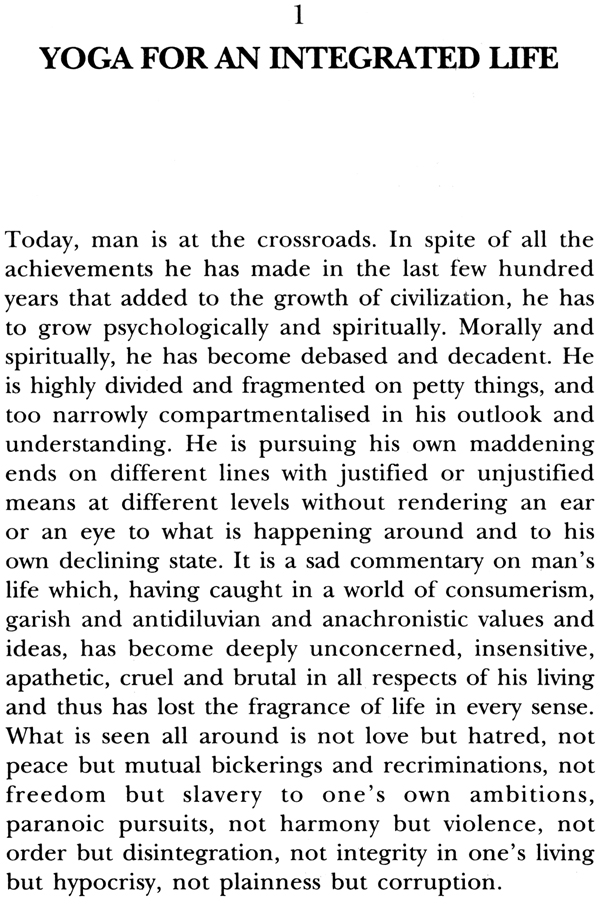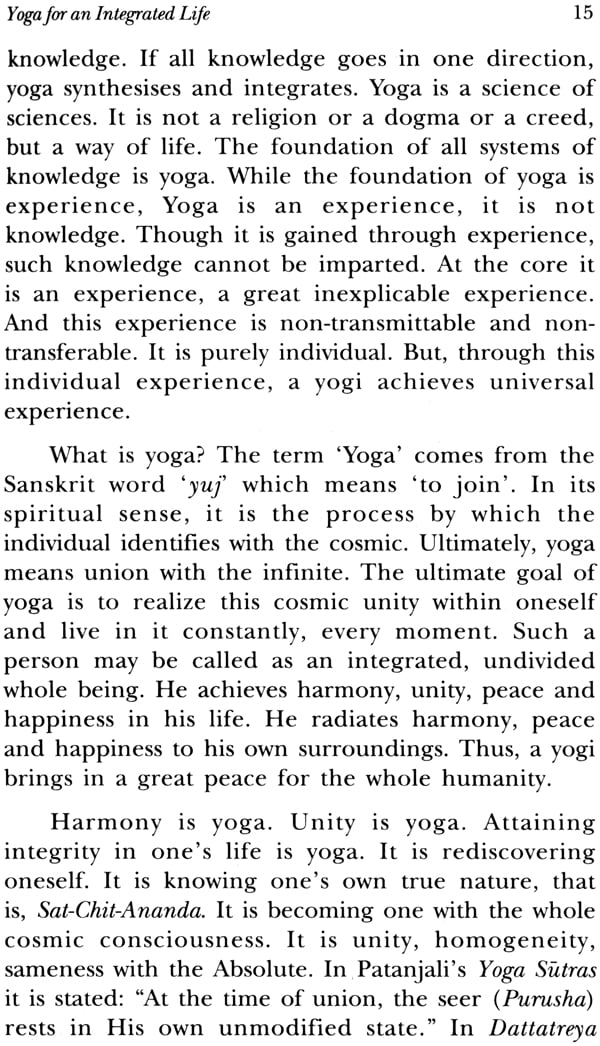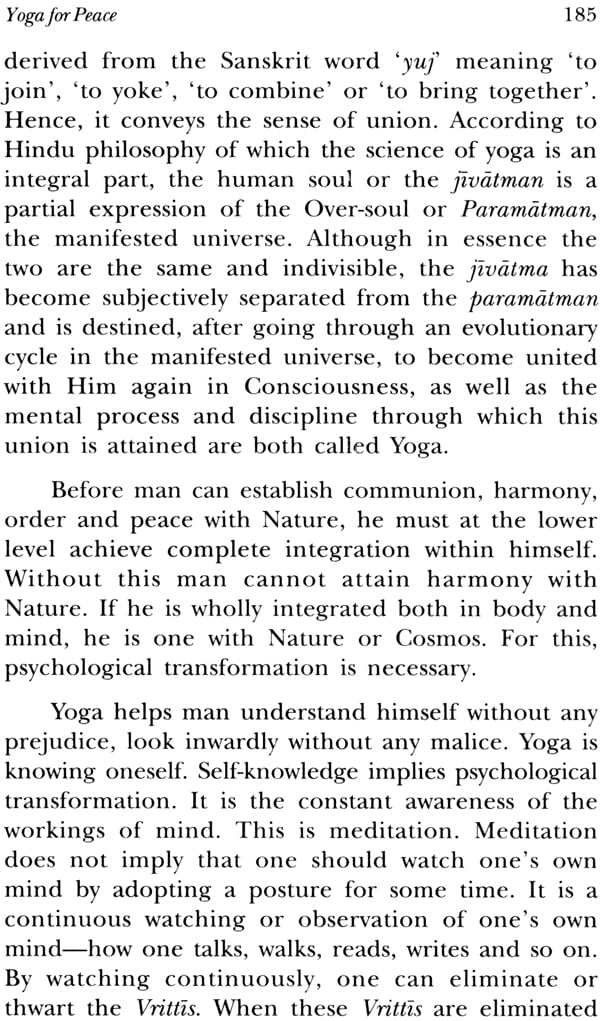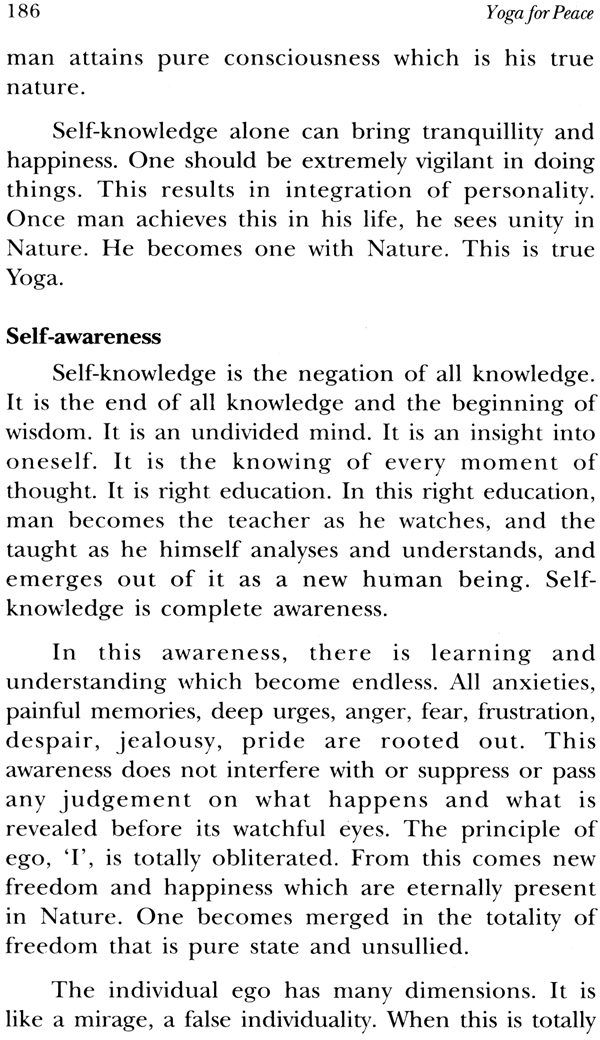
Yoga For Peace
Book Specification
| Item Code: | IDI795 |
| Author: | K. V. Raghupathi |
| Publisher: | Abhinav Publication |
| Edition: | 2007 |
| ISBN: | 817017483X |
| Pages: | 191 |
| Cover: | Hardcover |
| Other Details | 8.8" X 5.5 |
| Weight | 420 gm |
Book Description
From The Jacket
In India and abroad yoga seems to be different things to different people, with the result the original and pure yoga as expounded by the great sage Patanjali two thousand years ago actually has become drained, diluted, remote, shallow, unreachable and unrecognizable. The path of True Yoga actually leads one out of darkness into the light; and it is a perpetual journey into the mysteries of life. It takes up and leads us unfailingly and unerringly to the heights of greater splendour and glory where perfect peace, harmony and wisdom reign supreme. But his goal of yoga can only be reached through a regenerated, spiritual mind; a mind which is pure, subtle and sensitive. Needless to say, this yoga is missing now. It is misunderstood, misconceived into something by various names, gymnastics, fakirism, beauty culture and therapy, health science, six therapy, meditation technique and so on. Against this backdrop, the essays are framed on the basis of the first two sections, namely, Samadhi Pada and Sadhana Pada of Patanjali's Yoga Sutras. these are originally condensed talks delivered at Sri Aurobindo Society, Tirupati. In preparing these essays, the writer has drawn both upon his own experience and the Yoga Sutras. Ultimately, the only pure yoga is in living, constantly purifying oneself, leading to the discovering of oneself. The reader will find it useful and perhaps even illuminating to dispel certain misconception.
Born in 1957, Dr. K. V. Raghupathi received his postgraduate degree in English Literature in 1979, M. Phil in 1982 and Ph. D. in 1997 from Sri Venkateswara University, Tirupati, and PGDTE (Post Graduate Diploma in Teaching of English) from CIEFL, Hyderabad. He began writing seriously in 1985. Since then he has published innumerable poems, articles and book reviews in various literary and cultural journals and magazines of high reputation, participated in seminars and conferences, presented research papers and delivered lectures and public talks on literature, language, yoga, religion and spiritual life. He has so far published seven books in English verse: Desert Blooms (Kolkata, 1987), Echoes Silent (Kolkata, 1988) The Images of a Growing Dying City (Kolkata, 1989), Small Reflections (Kolkata, 2000), voice of the Valley (New Delhi, 2003), Wisdom of the Peepal Tree (New Delhi, 2003) and Samarpana (New Delhi, 2006). He is a recipient of several awards, notably, H. D. Thoreau Fellowship 2000 (Dhvanyaloka, Mysore), Michael Madhusudan Academy Award 2001 (Kolkata) and the Chosen Best Poet of 2003 by the Poetry Society of India, New Delhi and Poetry Chain, Mumbai. He began his yoga Sadhana in 1985 in Patanjali's tradition. He is a great lover and promoter of classical Karnatic music. He lives and teaches in Tirupati.
Preface
This volume has twenty essays, a few of them have been published in the Vedanta Kesari (Ramakrishna Math, Chennai) and Saptagiri (TTD Publication, Tirupati) over a period of six years. The essays Spiritual Value of Yama, Spiritual Value of Niyama, Sthira Sukham Asanam, Pranayama, Pancha Klesas, Pancha Vrittis, Nava Viksepas, Two Kinds of Yogis, Two Kinds of Samadhi and Karma and Yoga are the condensed forms of my talks on the first two parts (Samadhi Pada and Sadhana Pada) of Patanjali's Yoga Sutras which I delivered at Sri Aurobindo Society, Tirupati in 2003-2004 with a view to correct and dispel certain distortions and misconceived ideas of yoga as it is practised and imparted by certain yogic schools which have come up like mushrooms in our country and encashed on it by offering different kinds of modified versions of yoga in different bottles. In these so-called schools and institutes yoga is viewed, understood and practised only from the health point. Unfortunately, this sacred holistic science has been reduced to a mere mockery of acrobatics. It has been reduced to a mere therapeutic drug sold in the market. What is more ridiculous is that competitions are held at district, state and national levels and prizes are given to the best performers of asanas. Amidst this pulp and pseudoism the real prey is our own original yogic science as given by Patanjali two thousand years ago. It is with a view to retrieve this lost pure tradition I took up the venture of delivering talks to a limited enlightened audience when the invitation came to me from the trustees of Sri Aurobindo Society at Tirupati where I live. The offer provided me a wonderful opportunity to speak out the pure yoga which was given to the humanity by the great sage, Patanjali. The audience was very receptive and they received my talks with great enthusiasm and high spirit of understanding. Although I could not reproduce my original talks, world by word, which would have run into several hundreds of pages if I had done so, I honestly believe that the condensed form would unfailingly meet the requirement and serve the purpose. With this stout belief and constant hope, I have tried to convey the essence as it is found in the aphorisms without distorting it.
In the first essay Yoga for an Integrated Life, the importance of our ancient Yoga in achieving an integrated and harmonious life ha been stressed. The second essay Yoga and Western Psychology traces the history and development of Western Psychology, brings out the shortcomings in it and points out how the ancient Yoga of our tradition has surpassed it by transcending the mind. The third essay Dimensions of Yoga deals with various false nations associated with it. In the fourth essay Therapeutic Values of Yama and Niyama, the ethical and medicinal value of Yama and Niyama in spiritual life has been presented in detail.
The significance of ten cardinal virtues of Yama and Niyama in the context of spiritual life has been brought out in the next two essays, Spiritual Value of Yama and Spiritual Value of Niyama. The third important limb asana and what exactly it stands for as it is given in the original text Yoga Sutras has been succinctly explained in the essay Sthira Sukham Asanam. In Pranayama its importance in the practice of yoga as expounded by Patanjali, its functions, kinds and its benefits have been discussed elaborately.
Pancha Vrittis examines the five modifications as given by Patanjali in his Sutras and the method of elimination. Pancha Klesas deals with the five causes of misery and their removal. In the essay Nava Viksepas, nine forms of disturbances that come in the way of meditation and the ways by which they can be overcome have been presented in greater detail. In Two Kinds of Yogis, the differences between Bhava Pratyaya Yogis and Upaya Pratyaya Yogis have been discussed. Two Kinds of Samadhi deals with Samprajnatha Samadhi and Asamprajnatha Samadhi as dealt with by Patanjali. The Doctrine of Karma, its implications, various kinds of Karmas and how Yoga can break the cycle have been dealt with elaborately in Karma and Yoga.
In Yogic Walking for Relaxation a new idea of yogic waling has been presented. Aspects like how it should be done and how total relaxation can be achieved have been explained. Yoga and Ayurveda deals with their importance from the point of health. The idea that Ayurveda can be a companion Science to yoga and how Ayurveda can help sadhakas in their yogic life have been discussed. In Yoga: A Science of Relaxation a comprehensive approach to it has been presented. Food and Yogic Sadhana emphasizes the importance of Satvic food in yogic Sadhana. Yoga as an Art of Social Reconstruction deals with yoga from the artistic perspective. It is the greatest of all great arts because it essentially deals with human life in its totality. Yoga and Peace expounds how yoga can be used to achieve not only individual peace but also world peace.
| Preface | 7 | |
| Acknowledgements | 11 | |
| 1 | Yoga for an Integrated Life | 13 |
| 2 | Yoga and Western Psychology | 23 |
| 3 | Dimensions of Yoga | 33 |
| 4 | Therapeutic Values of Yama and Niyama | 39 |
| 5 | Spiritual value of Yama | 49 |
| 6 | Spiritual Value of Niyama | 59 |
| 7 | Sthira Sukham Asanam | 69 |
| 8 | Pranayama | 75 |
| 9 | Pancha Vrittis | 91 |
| 10 | Pancha Klesas | 99 |
| 11 | Nava Viksepas | 107 |
| 12 | Two Kind of Yogis | 119 |
| 13 | Two Kinds of Samadhi | 123 |
| 14 | Karma and Yoga | 129 |
| 15 | Yogic Walking for Relaxation | 139 |
| 16 | Yoga and Ayurveda | 145 |
| 17 | Yoga: A Science of Relaxation | 161 |
| 18 | Food and Yogic Sadhana | 169 |
| 19 | Yoga as an Art of Social Reconstruction | 175 |
| 20 | Yoga for Peace | 183 |
| Index | 189 | |













